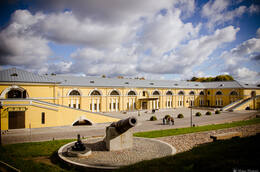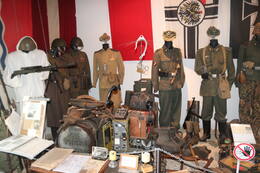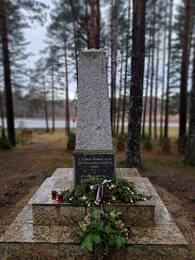Latgale – the Eastern Border of Latvia
Day 1.
120 km
Daugavpils - Aglona - Rušenica - Rezekne
Practical info
- The itinerary is intended as a guide - how to optimally travel a region or country, or two countries, with the aim of getting to know their military heritage;
- The driver must plan for himself - how many of the recommended objects and places he can explore in one day;
- Before traveling, you should check the opening hours of sightseeing places (museums, collections, fortifications, etc.);
- In places where advance registration is required (local guides, private collections, other), a visit must be booked, specifying the date and time. If the trip is canceled, the registered places must be informed;
- Accommodation must be booked in advance. Accommodation may be unavailable during the summer season, especially on the coast. Some catering establishments may not be open during the winter season;
- Choose not only summer for your trip, but also other seasons;
- The Latvian-Lithuanian-Estonian borders can be crossed by road freely without restrictions and at any time of the day. When entering from one country to another, you must have an ID card or passport with you;
- Visit tourist information centers where you can get additional information, brochures, and maps;
- To visit objects located in the Latvia-Russia-Belarus border regime zone, you must have a timed pass. For more information, see: https://www.rs.gov.lv/lv/pierobezas-joslas-rezims (LV, EN).
Sights
Daugavpils Fortress
Daugavpils Fortress is an architectural, cultural and historical heritage monument of national importance. It is the last bastion-type fortress built in the world and the only surviving example of a fortress from the first half of the 19th century in Central Europe, which has been preserved without significant changes.
Its construction began in 1810, as Tsarist Russia prepared for Napoleonic invasion, and continued until 1878. In 1812, Russian and French troops fought at the unfinished fortress. After the Napoleonic Wars, the construction of the fortress continued, however, already during its construction, it began to lose its military importance.
During World War I (1915–1918), the fortress served as a support and logistics base for the Russian Army. In February 1918, it was occupied by German troops, and in December – by Bolshevik forces. In January 1920, the fortress was recaptured by Polish troops, who helped the Latvian Army to liberate Latgale from the Bolsheviks. From 1920 to 1940, the 4th Zemgale Division of the Latvian Army was stationed in the fortress.
After the occupation of Latvia in 1940, Red Army units were stationed at the fortress, and during the German occupation, it became the site of the prisoner-of-war camp for Red Army POWs “Stalags-340”. After the second Soviet occupation in 1944, Soviet troops were again stationed in the fortress. Latvia regained the fortress in 1993 after the Russian Army had left.
Daugavpils Lead Shot Factory
The Daugavpils Lead Shot Factory, founded in 1885, is the oldest ammunition factory in Northern Europe, the only factory of its kind in the Baltic states, and one of the oldest industrial heritage sites in Latvia. It is home to Europe’s only operational lead shot tower.
Over the centuries, the factory has been producing high quality hunting shots and continues to do so today. The factory preserves equipment and structures from the 19th century, which have been supplemented before and after the World Wars. Modern equipment is used to produce ammunition.
Visitors can see the historical exhibition and the shot casting workshop, as well as climb the unique 31.5-metre-high tower of the plant, beneath which a 13.5-metre-deep cooling well is situated. This factory is a popular tourist destination that attracts both local and foreign visitors, enabling them to discover the industrial heritage of the 19th century and see the old machinery in action. After the factory tour, visitors can test the products made at the shooting range of the factory
WW2 – World War II Exhibition
WW2 – World War II exhibition in Aglona or the War Museum was established in 2008 and is one of the most extensive and interesting expositions of this kind in Latvia. The collection has been continuously supplemented with new acquisitions and stories of war participants and people of the wartime generation.
The core of the museum consists of weapons, equipment, ammunition, and uniforms used during World War II. In addition, there are household objects, fragments of aircraft wrecks and other exhibits. One of the most precious and unique exhibits is the Feldpost (field post) correspondence between Oberleutnant August and his lover Martha, which created a dialogue between two loving people with a happy ending during the period of the five years of war. Wartime chronicles are displayed in the background of the exhibition.
The exhibition is not politicised and reflects both sides of the war equally, allowing viewers to perceive it without making judgements of good or bad, which makes the exhibition easy to understand.
Monument to the Latvian Freedom Struggles at the site of the battles of the 3rd Jelgava Infantry Regiment
Monument to the 3rd Jelgava Infantry Regiment's January 16, 1920, freedom struggle in Latgale. With the inscription: “The place of the 3rd Jelgava Infantry Regiment's battles, the victory march through Latgale. 1920.16.I. We brought the sun, freedom and independence to Latvia”
The monument was unveiled in 1936. On August 16, General Žanis Bachs (1885–1941) consecrated it by Pastor Ādams Vizulis (1891–1970). The author of the monument's design was Engineer Zilēvičs.
The Latvian War of Independence (1918–1920) operation to liberate Latgale began on January 3, 1920. By mid-January, the Latvian and Polish armies had liberated Daugavpils and most of southern Latgale up to the Dagda–Indra line from the Bolshevik forces that had seized power in Russia. On January 9, the Latvian army began its offensive in Northern Latgale, rapidly advancing towards the Kārsava and Pitalova stations.
In the middle between the two directions of attack remained the Bolshevik-controlled area around Varakļāni, Viļāni and Rēzekne. On January 20, Latvian army units began the operation to liberate Rēzekne. Rēzekne was liberated on January 21. The Latvian army, across the entire expanse of the Eastern Front, reached the border of Latvian-inhabited lands by the end of January. Already on February 1, Soviet Russia signed an armistice agreement with Latvia.
With the victory in the Battles of Latgale, Latvia's eastern border was secured and the opportunity to annex Latgale to Latvia was gained. The Latvian army achieved the final unification and independence of Latvia in 1920.
The monument, dated 1920.16.I., is dedicated to the moment when the 3rd Jelgava Infantry Regiment took up its starting positions before the operation to liberate Rēzekne.
Places to eat
- In Daugavpils see visitdaugavpils.lv
- Terrace “Egle” and café “Somersēta” in Aglona
- In Rezekne see visit.rezekne.lv
Places to stay
- In Daugavpils see visitdaugavpil s
- For Aglona see latgale.travel
- In Rezekne see visit.rezekne.lv







